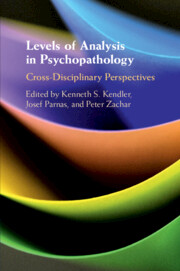Book contents
- Levels of Analysis in Psychopathology
- Advance Praise for Levels of Analysis in Psychopathology
- Levels of Analysis in Psychopathology
- Copyright page
- Contents
- Figures
- Tables
- Contributors
- Preface
- General Introduction
- Part I Neuroscience, Mechanisms, and RDoC
- Part II Phenomenology, Biological Psychology, and the Mind–Body Problem
- Part III Taxonomy, Integration, and Multiple Levels of Explanation
- Section 8
- Section 9
- Section 10
- Section 11
- Section 12
- Section 13
- 37 Introduction
- 38 The Impact of Faculty Psychology and Theories of Psychological Causation on the Origins of Modern Psychiatric Nosology
- 39 Commentary on “The Impact of Faculty Psychology and Theories of Psychological Causation on the Origins of Modern Psychiatric Nosology”
- Section 14
- Section 15
- Index
- References
39 - Commentary on “The Impact of Faculty Psychology and Theories of Psychological Causation on the Origins of Modern Psychiatric Nosology”
from Section 13
Published online by Cambridge University Press: 02 April 2020
- Levels of Analysis in Psychopathology
- Advance Praise for Levels of Analysis in Psychopathology
- Levels of Analysis in Psychopathology
- Copyright page
- Contents
- Figures
- Tables
- Contributors
- Preface
- General Introduction
- Part I Neuroscience, Mechanisms, and RDoC
- Part II Phenomenology, Biological Psychology, and the Mind–Body Problem
- Part III Taxonomy, Integration, and Multiple Levels of Explanation
- Section 8
- Section 9
- Section 10
- Section 11
- Section 12
- Section 13
- 37 Introduction
- 38 The Impact of Faculty Psychology and Theories of Psychological Causation on the Origins of Modern Psychiatric Nosology
- 39 Commentary on “The Impact of Faculty Psychology and Theories of Psychological Causation on the Origins of Modern Psychiatric Nosology”
- Section 14
- Section 15
- Index
- References
Summary
Kendler’s chapter provides a compelling account of how little evolved important premises of twentieth- and twenty-first-century psychopathology concepts represented in the Diagnostic and Statistical Manuals (DSMs) are from frameworks developed in earlier centuries that came to the fore in the nineteenth century, emphasizing a categorical distinction between cognition and emotion in characterizing broad classes of disorders. He then poses questions about how the recent NIMH Research Domain Criteria (RDoC) initiative relates to that heritage. The present commentary similarly places RDoC in that tradition yet differentiates RDoC from the DSMs. By design, RDoC is nonreductionistic and initially much less comprehensive and much more research based, largely confining its substantive elements to intersections of well-developed psychological constructs (important in but not confined to) psychopathology with well-developed psychological and biological data. As such, RDoC is much better positioned to support and drive recently growing interest in computational psychiatry.
Keywords
- Type
- Chapter
- Information
- Levels of Analysis in PsychopathologyCross-Disciplinary Perspectives, pp. 479 - 490Publisher: Cambridge University PressPrint publication year: 2020

